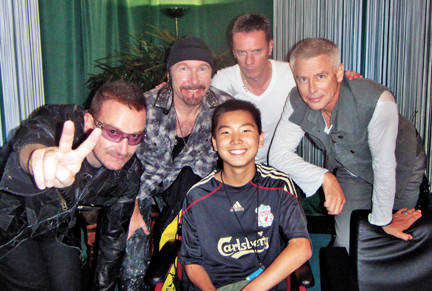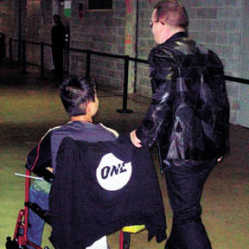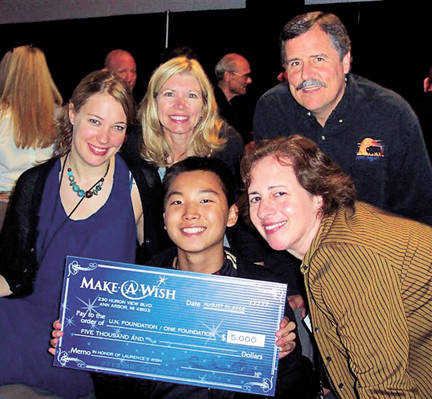Posted: Friday, September 25, 2009 5:26 PM
By John Baiata, NBC News’ Senior Editor
EAST RUTHERFORD, N.J. – Political activism from rock stars has a long lineage. You can trace it all the way back to George Harrison's "Concert for Bangladesh" in 1972, the "No Nukes" concert in New York in 1979, "LIVE AID" and "We Are the World" in the 1980's, and many more. Today such activism is ubiquitous. Concert-goers are urged to support a wide range of causes, and artists' web sites act as grass-roots organizations for a multitude of high-minded projects.
But no band – and no band leader – embodies this ideal more today than U2 and Bono. The band supports the efforts of Amnesty International, Greenpeace, and the Chernobyl Children’s Project. Bono has used his fame to put considerable pressure on countries to reduce the burden of debt on developing countries and to draw attention to the fight against AIDS in Africa with his RED project.

Lead singer Bono of the rock band U2 performs with the band during their 360 world tour stop at Giants Stadium in East Rutherford, NJ on Thursday.
U2 was the first big band to play in Sarajevo after the Bosnian war, launched an effort to put thousands of musical instruments back in the hands of New Orleans artists after Katrina, and have been very vocal in their support of Burmese opposition leader Aung San Suu Kyi.
Many of their songs over the years have drawn on socio-political events for inspiration – from the fighting in Northern Ireland to the civil war in El Salvador.
The band’s latest world tour, in support of their most recent album, "No Line on the Horizon," has drawn praise from critics. The tour’s latest stop, at Giants Stadium in New Jersey, sold out for its two nights. With 84,000 attendees per night, that’s more over 160,000 to rally to the cause(s) in just two nights. (According to U2's Web site, they broke every record for attendence in the stadium - breaking the record previously set by Pope John Paul II in 1995.) Do the math for the rest of the tour, and you begin to understand the extent of the band’s reach, and that of others with similar followings.
But what’s the real draw, the music or the message?
For Kevin Sheridan, 37, an advertising salesman from Malverne, N.Y. the two go hand in hand. "I tend to like those (musicians) with a message. Usually the music is better, because it comes from the heart." Sheridan drew the line when it comes to Hollywood, however. "These artists write their own music, which reflects their views, and you know going in where they stand. But I don’t want to be preached to by someone just because they’ve starred in a movie."
Blair Thill, 22, of Little Silver, New Jersey, said Bono’s activism was part of what attracted her to the band to begin with. His involvement in the fight to eliminate AIDS in Africa even inspired her to do a fundraising bake sale during high school in support of the cause. But, she said, "I would venture to say most people are going to this concert for the music, not a social cause."

Images of Burmese opposition leader Aung San Suu Kyi during a song dedicated to her.
Dori Kenyon, 38, a representative for Amnesty International manning one of several booths outside the venue, did not entirely agree. "You get all types. Some people are here because they [U2] have been around for 30 years, and they love the music…There are others who are here because they believe in what we’re doing, and Bono supports that."
Kenyon had made the drive from Lancaster, Pennsylvania with her son because she said, "We have a responsibility to everyone around the globe." She was collecting signatures in support of three causes – a bill guaranteeing maternal health benefits for women in the U.S., a petition urging U.S. lawmakers to deliver a plan that fulfills "the human right to health care," and another urging the release of Aung San Suu Kyi and all other "prisoners of conscience" in Myanmar.
Suu Kyi was in the spotlight on this night almost as often as the band members.
The group’s Web site encouraged fans attending the show to download and print a mask of her face, and to wear it during their performance of "Walk On," a song written for her. Her image was beamed over the giant video screens above the set as Bono talked about her lengthy detention and fight for freedom.
Her plight was probably news to most in attendance. Not a single fan I spoke to beforehand had even heard of her, and no one visible in the crowd had donned the mask of her image.
Yet all eyes were on Bono as he spoke, and as he sang, in part:
"You could have flown away
A singing bird in an open cage
Who will only fly, only fly for freedom"
South African Bishop Desmond Tutu’s video message to the crowd, which preceded the encores, received a raucous cheer. Tutu reminded the crowd that they were "the same people" who protested for civil rights in America, against apartheid in South Africa and the troubles in Northern Ireland.

A video message from Bishop Desmond Tutu preceded the encores.
A few minutes later we were reminded that contributions from Americans to the "ONE" campaign had helped deliver life-saving drugs to 34 million African schoolchildren, along with a couple of other encouraging statistics.
When the concert was over, those in attendance began to file out, talking excitedly about what they’d just witnessed. And while none I heard were talking about Aung San Suu Kyi, they’d all been given a primer as part of the price of admission.
fieldnotes














